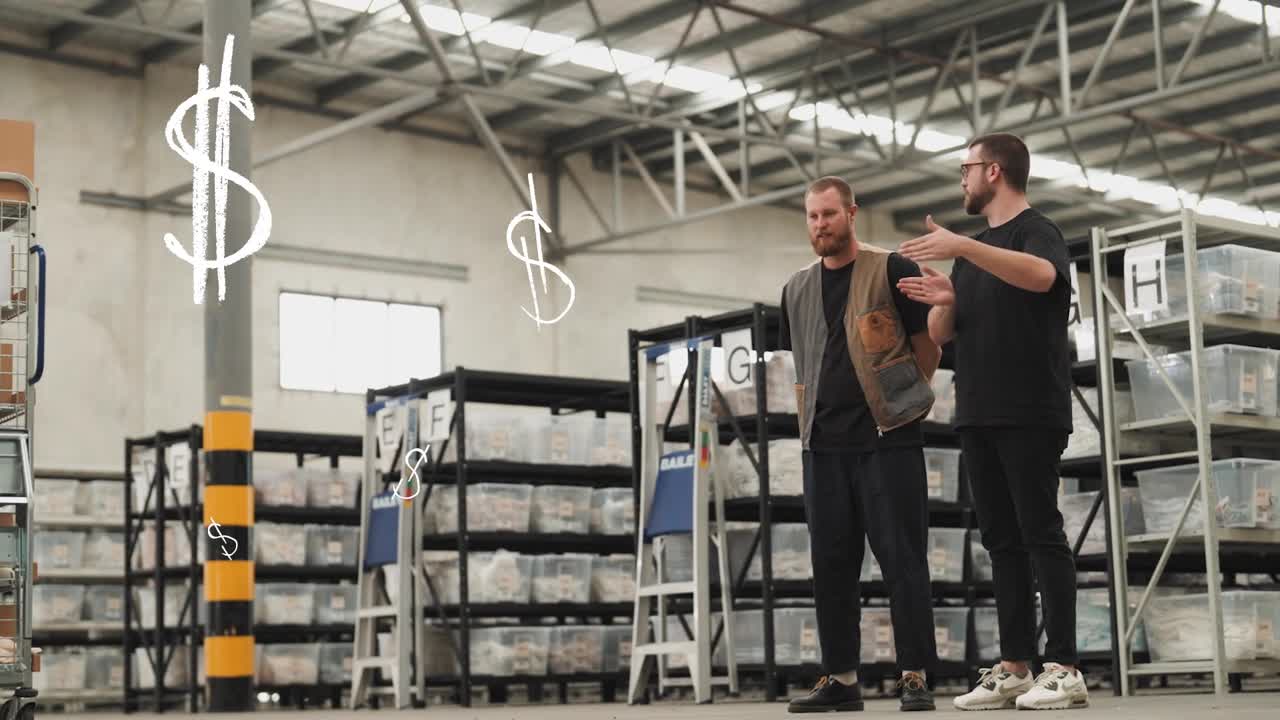A WMS, or Warehouse Management System, is a software application or system that can manage and optimise warehouse operations. By controlling the movement and storage of items within a warehouse, a WMS can help businesses ensure their processes are as efficient and accurate as possible.
Warehouse management software can be used to improve warehouse operations in a wide range of businesses at various sizes. Implementing a WMS can refine warehouse operations by reducing errors; lowering operational costs and provides a better customer experience through faster and more accurate order fulfillment.
In this overview, we’ll cover the following:
What does a warehouse management system do?
What are the benefits of a WMS?

What does a Warehouse Management System do?
The key features and functions of a WMS typically include:
Inventory Management
- Tracking the location, quantity, and status of all items within the warehouse. This helps in reducing stockouts, overstocking, and product obsolescence.
Order Management
- Managing the fulfillment of customer orders, including order picking, packing, and shipping. A WMS optimises these processes to reduce errors and improve order accuracy.
Goods-in Processing
- Scanning incoming items and reconciling them against purchase orders. Warehouse management systems can help determine where to store products in the warehouse and organise items based on factors like size, weight, and demand.
Picking and Packing
- Providing guidance for picking items from their storage locations and packing them for shipment. Optimising picking routes will minimise travel time and increase productivity.
Real-time Tracking
- Offering real-time visibility into inventory levels, order statuses, and warehouse activities. This helps in making informed decisions and quickly addressing any issues that may arise.
Reporting and Analytics
- Generating reports and providing analytical tools to help warehouse managers monitor performance, identify bottlenecks, and make data-driven improvements.
Barcode and RFID Integration
- Integrating with barcode or RFID technology facilitates accurate tracking and scanning of items throughout the warehouse.
User Management
- Some warehouse management systems include labour management features to track the productivity of warehouse staff, optimise workforce allocation, and set performance standards.
In addition to these features, a WMS will often integrate with other technology to provide even greater visibility and control of processes and workflows.
Watch our ‘WMS Explained’ series to gain a deeper insight into the features and functions of a warehouse management system.
What are the benefits of a WMS?
There are a multitude of benefits of a warehouse management system, from speeding up the pick, pack, dispatch process to reducing the volume of temporary staff through peak periods. The key feedback we hear from our customers is:
Improved Efficiency
- Using a WMS to optimise processes like pick, pack and dispatch enables warehouse teams to be as productive as possible. Reducing travel time through the warehouse by suggesting optimal picking routes ensures staff can process a higher volume of orders.
Inventory Accuracy
- With features like barcode scanning and real-time tracking, a WMS reduces the likelihood of errors in inventory management, order fulfillment, and shipping, resulting in higher order accuracy.
Better Customer Experience
- Orders arriving with customers faster and with fewer errors will result in better customer satisfaction. This will improve the chances of repeat purchases and help build customer loyalty whilst reducing customer service enquiries and negative reviews.
Cost Reductions
- Better stock control will typically see a reduction in reducing overstocks or stockouts. Improved order accuracy will mean fewer replacements and refunds. An optimised workforce will ensure staff are as productive as possible, so fewer temporary hires are required through peak periods of trading.
Team Management
- Utilising technology to manage your team more effectively will save time and free your warehouse managers up to work on other tasks. Ease of use means less time spent getting new hires up to speed and improved morale as warehouse staff can be effective from day one. A WMS can provide an audit trail to highlight areas for improvement.
A good WMS should provide seamless integration into your warehouse tech stack and improve your operations to prepare your business for growth. Scaling rapidly with unforeseen demand can be a make or break situation and having a suitable WMS in place will ensure your warehouse is not a bottleneck for your operations. The right software will grow with you and is a great investment in the future of your brand. Read more about our top warehouse efficiency tips.

What types of WMS are there?
There are 4 key types of WMS:
Standalone WMS: This type of WMS is installed and hosted on the organisation’s own servers and infrastructure.
Supply Chain Modules: This type of WMS is part of supply chain management software and allows businesses to control everything from one system for the entire supply chain.
Integrated ERP Systems: This type of WMS is part of an enterprise resource planning system which will typically include applications that allow businesses to manage all functions, such as HR, finance, procurement, etc.
Cloud-based WMS: This type of WMS is hosted online and will have an external IT and support system to maintain and update. A cloud-based warehouse management system can often be customised based on requirements and scaled up or down to suit business requirements. This is the type of WMS that Descartes Peoplevox offers.
| Pros | Cons | |
| Standalone WMS | – Offers full control over the software | – May be a costly investment upfront – Will require ongoing maintenance |
| Supply Chain Modules | – Better holistic view of supply chain | – Features and functionality can be broader than requirements to suit a wider range of purposes and business needs |
| Integrated ERP Systems | – Will be integrated more effectively with other business areas to provide a better overall view of whole business operations | – Often very costly for both implementation and ongoing subscription |
| Cloud-based WMS | – Quick to implement – a cloud-based WMS often requires minimal downtime for installation as it’s done online – Resource for maintenance not required as it will be included as part of subscription | – Less control over maintenance and improvement priorities as this will be done by the SaaS provider |
How much does a WMS cost?
The cost of a WMS will vary from supplier to supplier and the type of WMS you choose will also have an impact on the pricing. For a standalone WMS the cost will generally not be ongoing but for integrated supply chain modules, ERP software and cloud-based warehouse management systems there will usually be a subscription fee for ongoing use of the software. The features and functions needed can also impact warehouse management system costs, along with the size of the warehouse and number of users required. Read our most recent information about warehouse management system costs.

How do I choose a WMS?
Choosing the best warehouse management software for your business will depend on a number of considerations. Finding a good fit can be a lengthy process but it is important to take the time and make the right decision as it can have a huge impact on your business. We recommend thinking about the following when you are choosing a warehouse management system:
- Assess your requirements. It’s important to have a clear idea about why you need a WMS and what you’re looking to get out of your new WMS provider. Focus on the top 2-3 critical issues that are most affecting your warehouse and ensure any warehouse management software you consider can resolve these issues. Is the software scalable to fit your future business plans? A good WMS should be a long term solution rather than a short term fix, so it’s important to think about future needs as well as current.
- Consider your budget. Make sure to include any costs for implementation, training and any ongoing maintenance. Think about how costs may change based on pricing models – will extra charges apply if your warehouse grows, if you’re shipping more orders or if you hire more staff?
- Think about the functionality you need. Does your business have any unique requirements? Is a specialist WMS needed? What other software will your WMS need to integrate with? With so many options available, narrowing down the preferred type of warehouse management system may be a great first step. A standalone WMS can be a great option if you have a number of niche functions that are essential for your operations. A cloud-based option may be preferable if you don’t have the resource to maintain and manage the software internally.
- Are user reviews and recommendations available? Checking an unbiased source, like Capterra, can be a great way to find out how other businesses would rate the software you’re considering.
Peoplevox Warehouse Management System
Ultimately, a warehouse management system, or WMS, is designed to allow you to deliver items to your customers with the least amount of friction possible. A good WMS is essential for ecommerce businesses to operate as efficiently as possible and a great WMS will enable them to scale up. Peoplevox powers the warehouse operations of some of the most dynamic brands in the world. Ready to find out what we could do for your business?
See our success stories to find out more about how we work with some of the most dynamic ecommerce brands in the world:








